15+ Surprising Agile Statistics: Everything You Need To Know About Agile Management

Page Contents
- What Is Agile?
- Top Agile Statistics (Editor’s Choice)
- How Popular Is Agile?
- Advantages Of Agile Adoption
- Agile Adoption Statistics
- Agile Transformation Statistics
- Agile Trends and Predictions
- Agile Working Statistics
- Agile Industry Statistics
- Agile vs. Waterfall Adoption Statistics
- Agile’s Future is Bright?
- Conclusion
What Is Agile?
Agile Statistics: It is an iterative method of project management and software development that supports teams in providing value to their clients more quickly and with fewer headaches. Instead of focusing on the “big bang,” Agile teams deliver work in small but easily consumable increments. Additionally, teams have an easy way to quickly respond to changes by continuously evaluating plans, requirements, and results.
These Agile Statistics will discuss how and why this method has gained popularity, whether you are considering adopting it or just curious about the latest trends.
Top Agile Statistics (Editor’s Choice)
- Full Scrum usage can result in up to a 250% improvement in product quality.
- 98% of companies have become more successful because of Agile.
- The leading cause of 44% of Agile project failures is a lack of prior experience with Agile techniques.
- Projects under the competing approach known as waterfall only have a 49% success rate, while projects under the agile methodology have a success rate of 64%.
- Since 2002, more businesses adopting Agile have raised up to 88%.
- Companies have seen an average 60% increase in revenue and profit since using Agile.
- Around 88% of foreign employees and professionals believe that Agile improves their quality of life.
- Just 27% of manufacturing firms rely entirely on Agile.
- Generally, 9% of Agile projects fail.
- A minimum of 71% of United States businesses are now using Agile.
- This is why Agile projects are almost 1.5 times more successful than waterfall projects.
- The most well-known Agile framework is Scrum, which is used by 61% of respondents from 76 different Countries.
- 53% of the agile methodology marketing teams are more likely to follow hybrid methods.
- 78% of the managers in the United States of America believe that the implementation of agile and DevOps methods has shown a significant impact on the organization.
- According to Agile Statistics, the professional who handles related methodologies receives a salary between $120k to $300k.
How Popular Is Agile?
Agile is a software development methodology that has been gaining popularity in recent years. Agile emphasizes collaboration, customer feedback, and iterative development. Many organizations are adopting agile methods in order to improve their software development process. In this sub-point, we will take a look at how popular Agile is becoming and what factors are driving its popularity.
#1. Agile is the preferred method of implementation in federal IT projects (80%).
(Source: Goremotely.net)
As the world of technology continues to evolve, so too must the way in which we manage large projects. The traditional waterfall model simply isn't equipped to deal with the rapidly changing landscape of IT. That's why more and more organizations are turning to Agile.
Agile is a flexible, iterative approach that allows for constant adaptation and change. It's well-suited for projects that are subject to change or uncertain requirements.
Agile adoption isn't just for organizations outside of parastatals. More than three-quarters of all IT projects use an Agile approach.
#2. Agile adoption was beneficial for the FBI.
(Source: Goremotely.net)
Even the FBI is now adopting Agile. After two failed attempts at project management, the FBI found success with Agile. It speaks volumes about its effectiveness.
#3. Many Fortune 500 companies have adopted Agile.
(Source: Goremotely.net)
According to Agile adoption statistics, plenty of Fortune 500 companies have adopted Agile. It is one of the most popular project management methodologies in the world. Many people believe that it is the best way to manage software development projects. Why? Because Agile teams are able to build and deliver working software faster. And, since it is always changing, Agile allows for quick reactions to the needs of the business and end users.
Some of the biggest names in Agile adoption are Cisco, Microsoft, and IBM. This means that you too could benefit from Agile adoption.
#4. 27.4% of manufacturers depend solely on Agile.
(Source: Goremotely.net)
The manufacturing industry is also jumping on board, with almost one-quarter using Agile. More than half (50%) of the construction industry employs a combination, which can include Agile.
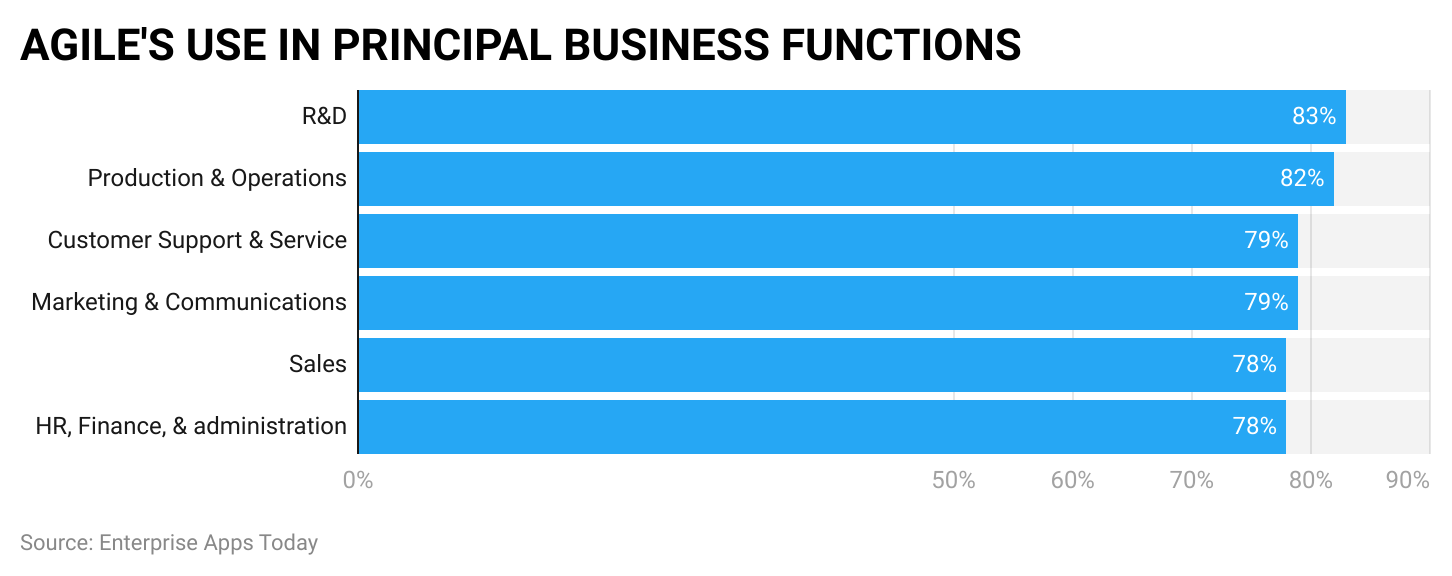
(Source: zippia.com)
Advantages Of Agile Adoption
Adopting Agile has some worthwhile advantages. This section will provide more information about these benefits and help you understand how Agile can work for your business. Here are some of the insights gleaned from our research.
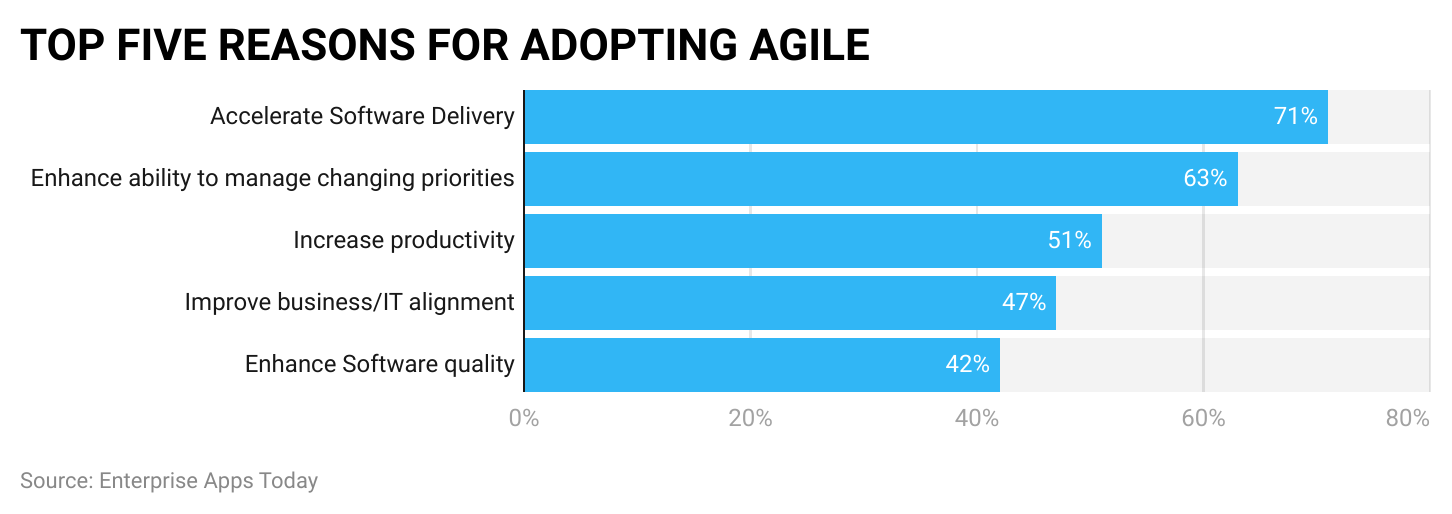
(Source: zippia.com)
#5. Full Scrum usage can result in up to a 250% improvement in product quality.
When different teams develop products using Scrum, defect density is drastically reduced. Those who didn't use Full Scrum experienced more than 20 defects, while those who adapted Full Scrum experienced less than 10 defects.
#6. Generally, 9% of Agile projects fail.
This is impressive and significant, particularly when compared with the waterfall methodology. Waterfall methodology experiences a 29% failure rate, which is more than 3 times higher than Agile.
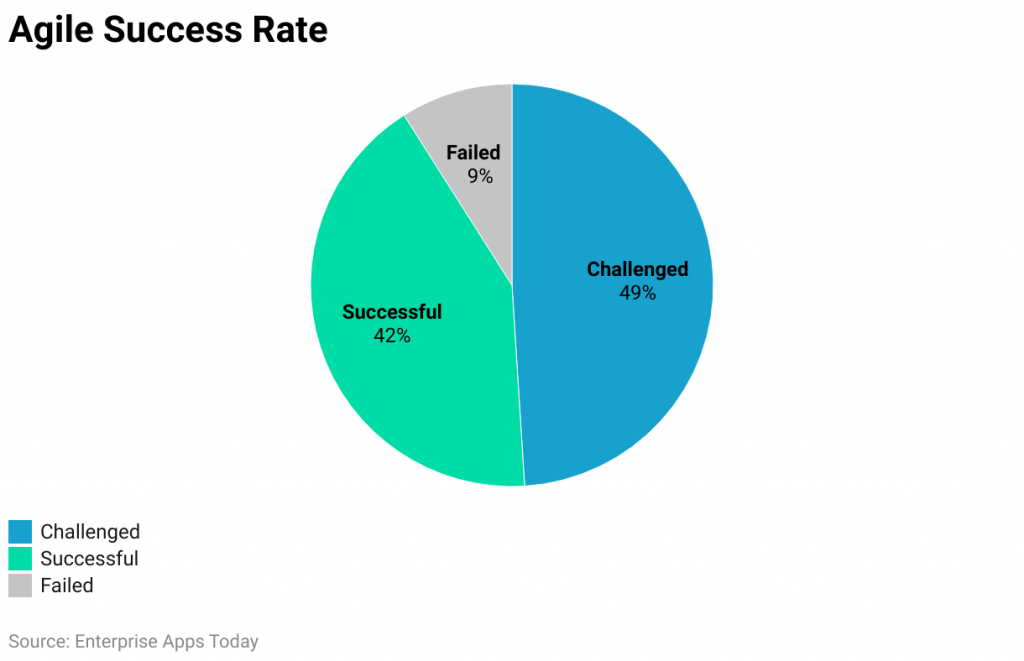
(Source: zippia.com)
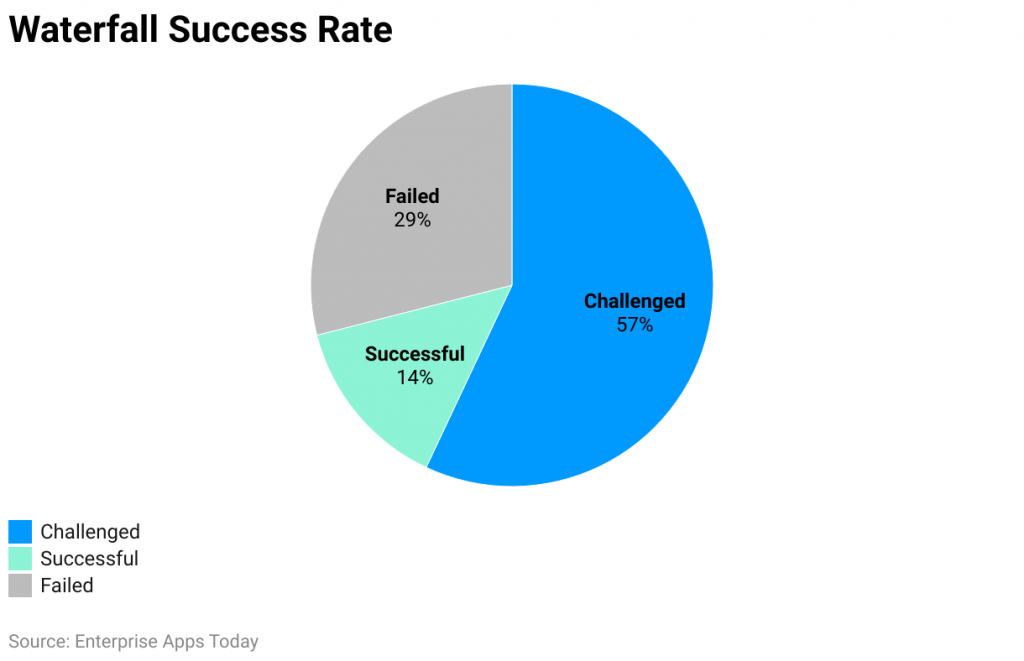
(Source: zippia.com)
#7. 98% of companies have become more successful because of Agile.
This is why it is not surprising that 71% of businesses are using Agile, and many Fortune 500 companies have also shown an interest in Agile.
#8. Agile projects are almost 1.5 times more successful compared to waterfall projects.
Agile initiatives are successful 64% of the time, compared to waterfall projects which are successful only 49% of the time.
#9. Agile teams are nearly 25% more productive.
These teams are also 50% faster to market than non-agile teams, which increases their long-term effectiveness. This is because Agile helps teams remain more concentrated on the current work.
Agile Adoption Statistics
Adopting Agile has many benefits for businesses, so many firms are switching. Agile results in more growth, quality, productivity, and other benefits. These are the facts:
#10. The leading cause of 44% of Agile project failures is a lack of prior experience with Agile techniques.
Other frequent causes of failure include organizational cultures that conflict with agile values (42%), poor management (38%), and external pressure to keep old traditions such as waterfall (37%). Doing so can be extremely expensive, as the American government has lost an astounding $32 billion because of IT project failures alone.
#11. Companies have seen an average 60% increase in revenue and profit since using Agile.
However, of nearly 1,300 IT and business leaders surveyed globally, just a tiny portion could fully deploy Agile and reap these benefits. Agile is, therefore, best applied when completely adopted rather than when just partially executed.
#12. Agile has been adopted by approximately 80% of federal IT projects.
This adoption is probably related to the trend toward smaller, less expensive IT initiatives, which is not the primary factor. For example, from 2004 to 2015, the duration of most federal IT projects was reduced from nine years to less than two years.
#13. Accountability, productivity, prioritization, collaboration, and feedback are the top 5 reasons teams choose Agile.
The last four of these help to boost productivity. Improved team focus and communication led to a nearly 25% boost in productivity on agile products.
Agile Transformation Statistics
These are the insights that you need to understand the role of culture in transformations.
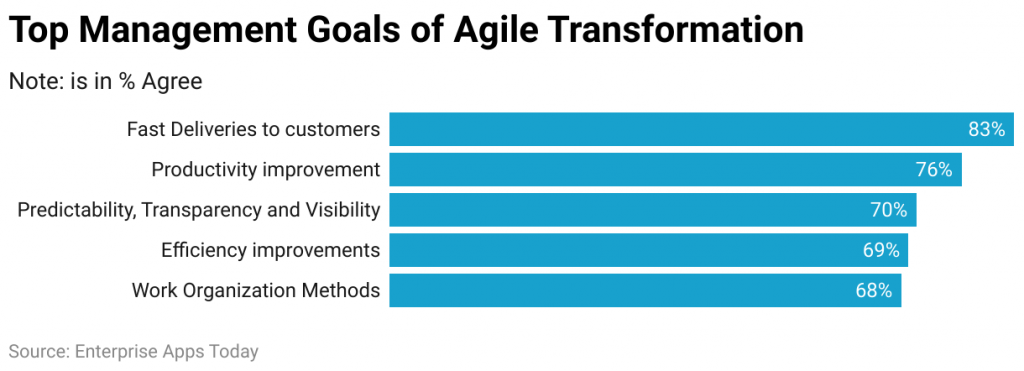
(Source: Parabol. co)
#14. How organizations measure the effectiveness of their employees They are successful in their agile transformations:
- 59% Customer/user satisfaction
- 58% Business Value
- Attained 50% Business goals
- 48% On-time delivery
- Quality: 48%
- 41% Productivity
- 41% Organizational Culture/Morale
#15. Only 13% responded to a KPMG survey stating that their top management fully supports agile transformation. (Source: KPMG)
#16. 68% agreed that leaders empowered them, but after accounting for cognitive bias, the neuroscience analysis revealed that only 17% felt empowered. (Source: JCURV)
#17 74% of organizations undergoing an Agile Transformation do not believe that their organization supports Agile culture. (Source: KPMG)
#18. 62% of top management think agile has no implications. (Source: KPMG)
Agile Trends and Predictions
Agile has undoubtedly gained popularity over the years, but how quickly has it grown? It's also crucial to analyze where this methodology will go in the upcoming years. Our research reveals that:
#19. JIRA software is a popular tool used in Agile management and development teams.
JIRA software is very popular because of its many features. For instance, Agile features in JIRA software include problem types, user bugs and stories, workflows, boards, roadmap, backlog, and reporting charts.
#20. In 2020, the adoption of agile methods accelerated, with 43% of companies reporting that their inclination in that direction has grown over the previous 90 days.
It could be due to a more significant number of remote workers. These workers need to communicate more effectively with one another. In fact, according to 33% of firms, Agile is being used to manage distributed teams.
#21. Since 2002, more businesses adopting Agile have raised up to 88%.
The percentage of businesses using Agile was just under 10% in 2002. But over time, that percentage increased to 80% in some industries. This is particularly true for federal IT projects, which have significantly shifted toward Agile methodology.
#22. The most well-known Agile framework is Scrum, used by 61% of respondents from 76 countries.
Scrum's most significant advantage is working simultaneously rather than sequentially. However, other most popular Agile frameworks include Extreme Programming, Kanban, Dynamic System Development Method, Lean, Feature Driven Development, Crystal, and many others.
Agile Working Statistics
Perhaps you are curious about the effectiveness of Agile adoption. Let's give you some statistics about the benefits of Agile adoption. For good measure, we'll throw in some Agile work statistics.
#23. 98% of companies have adopted agile practices.
This is the best thing about Agile. Nearly all companies who adopted Agile have seen benefits. We don't know of any other reason to encourage you to use Agile.
#24. CMOs report that 80% have seen an increase in productivity.
A new study reports that a majority of Chief Marketing Officers (80%) have seen an increase in productivity from their teams since the start of the pandemic. The research, which was conducted by The CMO Club and Engine Group, found that CMOs are finding new ways to work smarter and more efficiently in the face of challenging circumstances.
The pandemic has forced businesses to re-evaluate the way they operate, and many marketers have been able to find new efficiencies as a result.
#25. Microsoft Project is the most popular project management software.
Let's start by introducing you to the most popular project management tool. These Agile adoption stats show that Microsoft Project topped the list. There are no surprises!
Agile Industry Statistics
Agile adoption is becoming increasingly popular, although there are variations in popularity between specific industries. Based on our research:
#26. Around 88% of foreign employees and professionals believe that Agile improves their quality of life.
This information comes from a diverse group of respondents representing 91 nations and 27 industries. Considering this, most people who work with Agile concur with this.
#27. Just 27% of manufacturing firms rely entirely on Agile.
Although this number appears to be considerably lower than the other figures provided, a large portion can be attributable to a lack of complete implementation. For instance, nearly 56.6% of manufacturing firms rely on a combination of techniques, such as Agile.
#28. Agile is used by 86% of international software developers.
This indicates that the vast majority across the globe now employs the Agile methodology. Software development companies only intend to grow more agile over time.
Agile vs. Waterfall Adoption Statistics
Adopting a new software development methodology is a big decision for any organization. There are many factors to consider, and it's important to choose the right one for your company. Two of the most popular development methodologies are Agile and Waterfall. Both have their pros and cons, but which one is more popular?
According to a recent survey, Agile is the most popular development methodology, with 61% of respondents saying they use it. Waterfall came in second, with 32% of respondents using it.
#29. Agile adoption is now the norm and has overtaken Waterfall.
It's not surprising, given the many benefits associated with Agile. Agile adoption is increasing in popularity and being considered the norm by more companies.
#30. 14% more companies adopt pure Agile processes than Waterfall.
More and more companies are moving away from traditional Waterfall processes in favor of pure Agile processes. Agile is a more flexible and customer-centric approach that has been shown to lead to better results. In a recent study, 14% more companies reported adopting pure Agile processes than Waterfall. This trend is likely to continue, as Agile becomes more widely understood and accepted.
#31. Waterfall projects are less successful than Agile projects by 1.5x.
Let's look at things from a different perspective.
Agile adoption success rates average 42%, and Waterfall adoption success rates average 26%. These numbers are certainly worth considering.
#32. Agile has a failure rate of 8% while Waterfall has a failure rate of 21%.
Let's examine it from another perspective. A survey done in 2019 shows that the Agile failure ratio is almost three times less than the Waterfall. The former is clearly more advantageous.
Agile’s Future is Bright?
Agile projects have a higher success rate than Waterfall. Large Agile projects are twice as successful as Waterfall projects and have half the chance of failing. The success rate for small projects is 59% for Agile approaches and 56% for Waterfall. Medium-Agile Agile projects have a 31% success rate, compared with 19% for Waterfall.
Statistics on Agile adoption show that companies are abandoning traditional project management methods in favor of Agile. Agile is flexible and fast, which helps businesses improve their efficiency by allowing them to learn from each iteration.
Agile teams are able to anticipate future changes and manage shifting priorities. They can also provide feedback to stakeholders and clients as the project progresses. Agile also empowers teams and allows them to be creative, prioritize effectively, and help them prioritize.
Conclusion
Agile project management is an extremely popular software-building methodology, with roughly 71% of United States firms using it today. Additionally, 61% of respondents from 76 different countries currently use Scrum, the most widely used Agile framework.
This, combined with around 88% of international professionals and employees believing that Agile methodology improves their quality of life, is a sign of growth. After all, since 2002, when the percentage of businesses utilizing Agile was just under 10%, the number of companies using Agile has climbed to 88%.
As proved by Agile Statistics it will be more widely adopted and fully implemented because of its customer-centered approach to software development.
Sources
FAQ.
Scrum is the most widely used Agile methodology. The Agile framework is used by most respondents (61%) compared to all other frameworks. These respondents were spread out around 76 different countries, demonstrating that Scrum is the most widely used methodology across the globe, not just in the United States.
Scrum allows teams to work simultaneously instead of sequentially, which is why many individuals prefer it. This makes it easier for team members to work together on projects and complete them more quickly, especially when they are working remotely from different locations.
Extreme Programming, Kanban, Dynamic Systems Development Method, Lean, Feature Driven Development, and Crystal are a few additional well-known Agile frameworks.
At least 71% of American businesses utilize agile. Additionally, 61% of respondents from 76 countries indicated that they employ Scrum, making it the most well-liked Agile framework.
The number of businesses using Agile has climbed up to 88% since 2002, when about or just fewer than 10% of companies using Agile are still rising. This is notably true for federal IT projects, as Agile has been adopted for almost 80% of federal IT projects.
Agile project management is an iterative method of managing and building software development projects. Agile's key points include continuous releases and using every iteration to implement customer feedback.
On a basic level, Agile methodology builds software over time, starting with the beginning of the project and ending with the final project at the end of the cycle. If you are new, you might compare this to the creation of video games, where a beta version is made available in order to get feedback from players before the final product is made.
Agile is excellent because it enables a team to debug, critique, and enhance software more successfully during development. High-quality products are made possible by testing prototypes and getting client feedback.
Additionally, this system encourages prioritization and collaboration because it enables teams to assign jobs precisely, thanks to user input and Agile metrics.
Agile metrics are standards that aid in monitoring a software development team during a project's development. The team uses the metrics primarily to gauge their productivity and evaluate the caliber of their output. Agile metrics are a crucial part of creating software because of these factors.
Agile success is measured by determining if a project is finished on time or not. Although this is just one-way teams can measure their success with Agile, this is the most popular technique, according to 58% of survey respondents.
Delivering a project on time involves meeting expectations for what will be delivered by the deadline as well as completing the project by the specified time frame.
Product quality is the second most popular metric used to assess the performance of an Agile project, with 48% of respondents using it. This method requires that the software has consistently positive testing results.
Other measures of success include user/ customer productivity, satisfaction, and business value.
Agile technique is used in 80% of IT projects. This is by far the majority, and since Agile has been widely used, the average development time for these federal IT projects has decreased from 9 years to 2 years.
71% of businesses, including numerous Fortune 500 corporations, have used Agile in the private sector, and 86% of software developers worldwide adopt the methodology.
In 2020, when many businesses shifted to having most of their staff members work remotely, 43% of organizations said that they were moving more quickly to embrace Agile, with 33% of businesses stating that they needed it to assist them to manage teams whose members all worked remotely.

Michael Singer is a career coach, podcast host, and author to help you step into a career you're excited about. Currently, He is a coach and trainer helping entrepreneurs and executives achieve business and leadership success. He is also an award-winning business journalist focused on the intersection of technology, Big Data, Cloud, SaaS, SAP, and other trending technology.